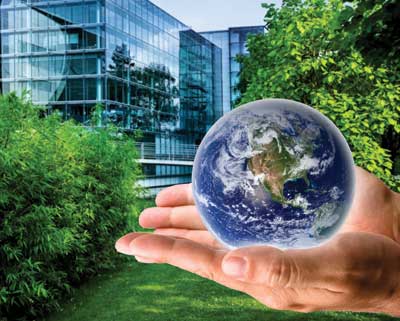|
|
|
Why Green Buildings Are Good

Green, the iconic color of plants, is the symbol for sustainability in buildings. Green is good for the facility’s triple bottom line (people, planet, and profit). Green buildings are:
- Good for occupants (healthier and more comfortable working space).
- Good for our environment (reduced resource depletion and higher sustainability, which helps preserve the earth for future generations).
- Good for business (higher employee productivity, lower energy and life cycle costs, higher client attraction/retention, higher resale value, and enhanced public relations).
Many people mentally equate green buildings with energy savings. Reducing energy use is indeed one critically important aspect of sustainability. Building energy efficiency is ENERGY STAR’s objective, and zero net energy use in a building is the ambition of the Energy Commercial Buildings Consortium (ZECBC).
However, being “green” is actually more comprehensive than “just” saving energy. Green buildings (compared to traditional buildings) have reduced environmental footprints while still enhancing the indoor environmental quality (IEQ) for the occupants. Green means getting more with less—more quality of life for building occupants while using less planetary resources.
Different categories for what constitutes “green” in buildings can be found, for example, in the U.S. Green Building Council (USGBC) LEED for New Construction and Major Renovations, which include:
- The Sustainable Sites category discourages development on previously undeveloped land and seeks to minimize a building’s impact on ecosystems and waterways, to encourage regionally appropriate landscaping, to reward smart transportation choices, to control stormwater runoff, and to reduce erosion, light pollution, the heat island effect, and construction-related pollution.
- The Water Efficiency category encourages reduced water usage, typically achieved through more efficient appliances, fixtures, and fittings inside and through water-wise landscaping outside.
- The Energy & Atmosphere category encourages a wide variety of energy strategies: commissioning, energy use monitoring, efficient design and construction, the use of renewable and clean sources of energy (generated on-site or off-site), as well as efficient appliances, systems, and lighting.
- The Materials & Resources category encourages the selection of sustainably grown, harvested, produced, and transported products and materials. It encourages the use of locally sourced materials to reduce transportation costs. It promotes the reduction of waste as well as reuse and recycling, and it takes into account the reduction of waste at a product’s source.
- The Indoor Environmental Quality category promotes strategies that can improve indoor air (where people average 90% of their day), provide access to natural daylight and views, and optimize acoustics.
The significant goals for “greener” buildings of reducing energy and water usage while enhancing the quality of indoor air constitute the majority of credits in the LEED system. These goals (and credits) are attainable to a large degree by optimizing the building’s automation system...which is what KMC products have been doing for decades. So when you are ready to build or renovate, let us help you achieve your triple bottom line.
Additional Resources
Additional Links
Feedback
|
|